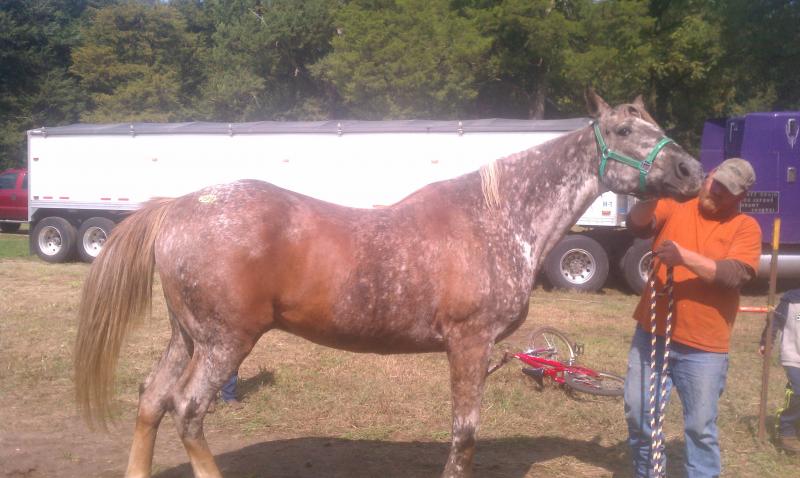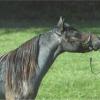What could cause this?
Forums
Alright, my post is awaiting
Alright, my post is awaiting approval, here is what I sent:
Hello,
I'm posting about this unusual horse for a group of curious color enthusiasts. This horse has shown up on a few internet forums and the owner has allowed asking around about their animal to figure out what color they may be. This is the owner's story about him.
[i]"I bought this horse on a sale on Sat. He doesn't have any paperwork, we also don't know if the Coggins that came with him are even his. The Coggins had no age, name or any distinguishing info. One lady we spoke to said she had him for 5 years (we never even got a name from her) but that didn't match up w/ Coggins either! He is very calm and broke to ride and I love him already I'm just curious. He (Camo) is 16'1-16'2 about 1350lbs and so many different colors! I'm sure he a combo of 2 horses so we may never know what he is. Also we haven't ridden him yet but he seems to be gaited. Any help or opinions would be greatly appreciated."[/i]
Many people think chimerism, LP or past skin damage are possibilities. So since LP is in those options we want to know what the LP experts at the Appaloosa Project think about him. ^_^
Thanks so much for taking a look.
Got a reply! They also don't
Got a reply! They also don't think it's chimerism and would like pics of his hooves and skin to get a better idea of possible LP status. Read on for Sheila Archer's interesting opinions on what might be causing his color. Dr. Sponenberg is possibly going to take a look at him too.
[i]
Thank you for sharing these pictures and the story behind them. This horse has a very unusual physical appearance, to be sure![/i]
[i]I don't think that this horse's coat pattern is due to the presence of LP. Though LP-caused roaning does vary in expression from one horse to the next, it does not tend to follow the distribution pattern of the depigmented areas on this horse.[/i]
[i]For comparison, here is a photo of a mare that has developed a lot of snowflake roaning (she eventually became almost totally white):[/i]
[i]http://www.appaloosaproject.info/images…]
[i]As you can see, these snowflakes are white, rounded blotches and they are scattered over the body more evenly than the patchy "zones" that Camo has. In contrast to her, he has areas where he's retained normal chestnut skin and hair (shoulder and flank).[/i]
[i]Also note that with this many snowflakes already, the Appaloosa mare has lost most of the pigment in the skin of her muzzle area. When LP-caused changes happen in the coat, they also affect the rest of the body...[/i]
[i]This being said, it does look like he might have white sclera, and some unpigmented skin on his muzzle. Pictures of his hooves and especially the region under the tail would be helpful. If LP is there, it will have written its signature all over this horse's body.[/i]
[i]As far as chimerism goes, it's very unlikely that this horse's patterning is due to him being a chimera. The physical appearance of known equine chimera's is quite specific. Vertical banding/striping is very narrow and wavy, and appears continuously from one end of the horse to the other. Here's an example:[/i]
http://www.appaloosaproject.info/images…
[i]This is a closeup of a confirmed chimera, the AQHA horse "Sharp One". As you can see, the two different coat colours are arranged in vertical stripes, like two different coloured decks of cards that have been shuffled together.[/i]
[i]To my eye, it looks like vitiligo, a poorly understood phenomena that can affect non-Appaloosa horses. A variety of possible causes have been suggested, including poor nutrition, damage from a physical process or disease (eg. fungus), or the presence of autoimmune disease. It is quite possible that a number of factors are at work in this horse. [/i]
[i]Dr. Sponenberg, if you have a moment, it would be good to have your opinion on this - what do you think?
Sheila Archer [/i]
Dr. Sponenberg replied. Hmm.
Dr. Sponenberg replied.
[i]Hmm. Beats me! I think Sheila explained it pretty well. The skin on the muzzle and eyes looks "wrong" for LP (no or little mottling), and the unaffected areas on the flank and barrel are also a bit odd. This has a patch distribution which does not make much sense! It is unlikely to be chimeric because of the lack of a vertical character to it. For that matter, it is unlikely to be vitiligo, either, as that usually hits the skin aroung the eyes as well![/i]
[i]If the muzzle IS mottled, then this is one very, very odd appaloosa pattern. In that case, the residual chestnut areas (unaffected by whatever is going on) could be those "mismarks" that some apps have. However - that would make this horse have two very rare things going on at once, that that is ... rare![/i]
--
[i]D. Phillip Sponenberg, DVM, PhD[/i]
Going to send the images over to them.
OK so I am not nearly as
OK so I am not nearly as knowledgeable as everyone else here, but I had a thought. What would we expect to see if this horse was going grey and WAS chimeric?
[img]http://i872.photobucket.com/albums/ab28…]
Could that be the case with the OP's horse? It doesn't exactly look like any greying pattern I have seen before... But horses love doing funky stuff to confuse me, so I try to think outside the box :rofl
Just sent the other images
Just sent the other images and info that the hooves are striped.
I'm leaning more towards somatic mutation of LP since it isn't uncommon. I personally don't think it's a chimera and somatic mutation is much more common. I wouldn't be against the owner sending in samples for a chimeric test though. In fact I'd donate some money towards it if that's what they decide to do. If I'm proven wrong about the chimera thing I'd still be ecstatic about the results.
I found the link
I found the link
I see your post, and raise
I see your post, and raise you some 'after' shots :grin:





Looks like either LP or skin
Looks like either LP or skin trauma causing discoloration and white scars. Need pics of the feet and skin to get a better idea. Looks like they might have white scleras?